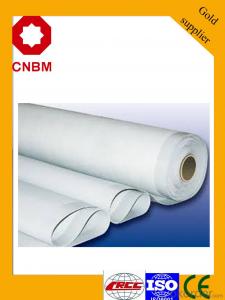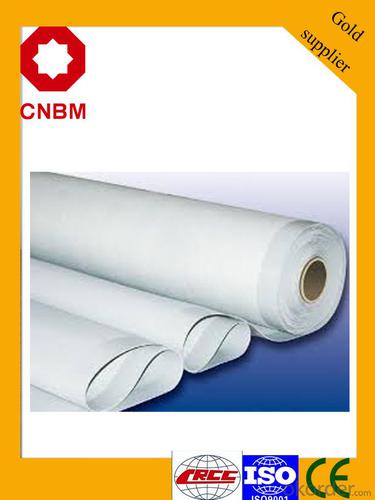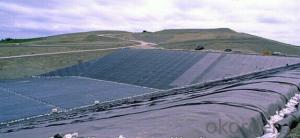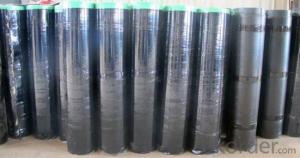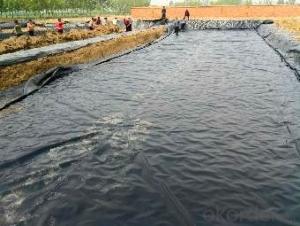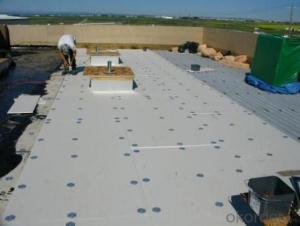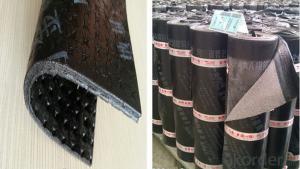Modified Bitumen Sand Surface SBS/APP Waterproof Membrane
- Loading Port:
- Shanghai
- Payment Terms:
- TT OR LC
- Min Order Qty:
- 44 roll
- Supply Capability:
- 100000 roll/month
OKorder Service Pledge
OKorder Financial Service
You Might Also Like
Product description
SBS modified bitumen waterproof membranes use high quality needle punched polyester mat or fiberglass compound mat as the base reinforcement. And use SBS modified bitumen as the dip-coat material. The SBS modified bitumen waterproof membrane are widely used for roof waterproof projects.
Specifications
1. Width: 125px-1m or as customized
2. Length: 3m/5m/10m/15m/20m or as customized
3. Thickness: 2mm/3mm/4mm/5mm
4. Surface: PE film, Colorful Sand, Mineral Granules or Aluminium foil
Technical Parameters
No. | Item | Index | |||||
I | II | ||||||
PY | G | PY | G | PYG | |||
1 | Solvend content(g/m²)≥ | 3mm | 2100 | - | |||
4mm | 2900 | - | |||||
5mm | 3500 | ||||||
Experiment phenomena | - | Carrier non-ignitable | - | Carrier non-ignitable | - | ||
2 | Heat risistance | °c | 90 | 105 | |||
≤mm | 2 | ||||||
Experiment phenomena | Non flow,dippage | ||||||
3 | Cold bending/°c | -20 | -25 | ||||
No crack | |||||||
4 | Waterproof 30min | 0.3MPa | 0.2MPa | 0.3MPa | |||
5 | Tensile strength | Maximum peak tensile(N/50mm)≥ | 500 | 350 | 800 | 500 | 900 |
Inferior peak tensile (N/50mm)≥ | - | - | - | - | 800 | ||
Experiment phenomena | In stretching process,the test specimen has no asphalt cracks or separate with the carrier | ||||||
6 | Elongation | Maximum peak elongation | 30 | - | 40 | - | - |
Inferior peak elongation | - | - | 15 | ||||
Product Feature
1. SBS modified bitumen waterproof membrane has good watertightness.
2. SBS modified bitumen waterproof membrane is high strength of extension, good ductility
3. SBS modified bitumen waterproof membrane is special used for low temperature.
4. SBS modified bitumen waterproof membrane is easy construction, can be constructed all of the year by the way of hot melt.
Application
1.Make sure the roof deck is smooth,clean and dry(Moisture<9%),then apply the surface of roof deck with a kind bitumen paint till dry.
2. There are two methods in application:
One way is by heating and melting method---Heat the membrane and roof deck surface by heating and melting method to be nearly melted(not flowing),then install the membrane fully bonded to the roof deck with overlaps of 5-250px.
The other way is by cold adhesive method---Pour the cold adhesive on the roof deck then roll the membrane to install it to be fully sticked to roof deck.
By heating and melting method and by cold adhesive can be used in alternation as requested.
3.After application,, a full serious inspection is required,that’s to make sure no air bubble,,no fold,,no falling away etc. and guarantee the waterproof life.
Requirements for construction
1.The base should be dry and clean. Do not work in the rainy or snowy day.
2.Do not work under heavy wind(above 5 grade)
3.Unsuitable for construction below 5°C
4.If it is rain or snow in the process of construction, protective measure to the laid membrane is must.
5.All the workers should put on special uniforms to keep safe when installing. There should be equipments for fire controls.
product show
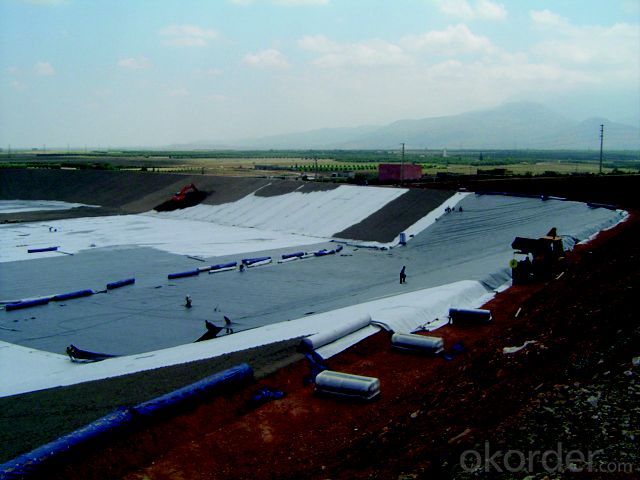

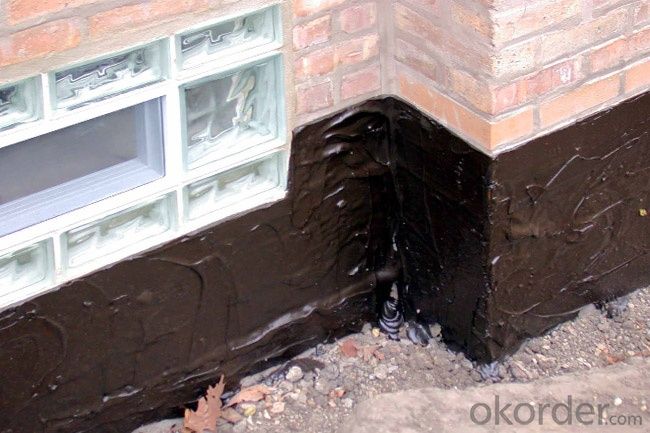

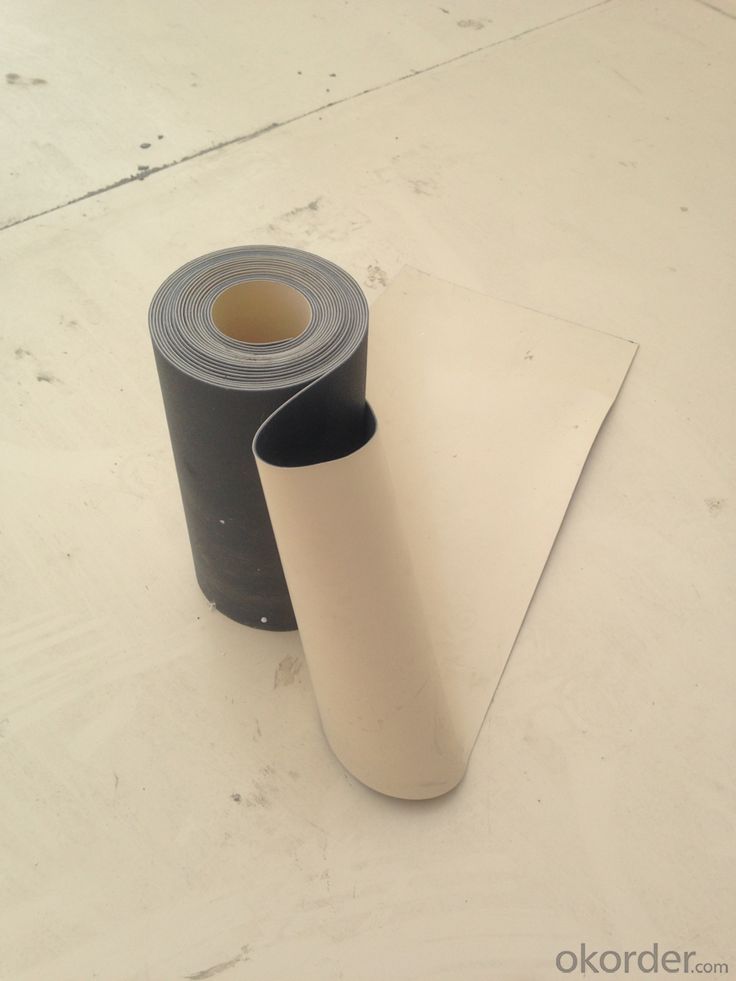
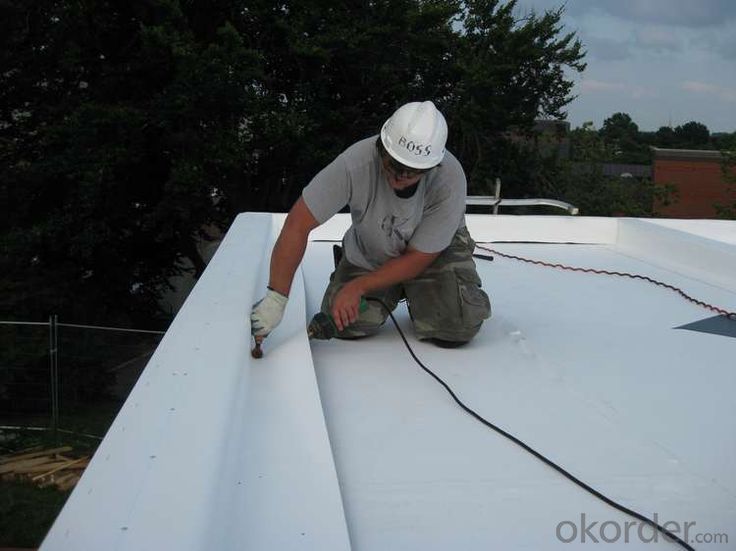
FAQ
Q: What's the delivery time ?
A: 3-5 days for 1-600 rolls, 10-15 days for container.
Q: What's the payment terms ?
A: TT/LC
Q: How do you make replacement with quality problems ?
A: New replacement will be packed into your next order or send to you directly after receive video or photo about quality problems.
- Q: Are waterproofing membranes resistant to high-pressure water jets?
- Waterproofing membranes are known for their ability to resist high-pressure water jets. They are specifically designed to create a barrier against water penetration and undergo testing to ensure their durability against different water pressures. The level of resistance may differ depending on the type and quality of the membrane. Nonetheless, waterproofing membranes are engineered to withstand high-pressure water jets, effectively safeguarding against water infiltration and potential harm to the underlying structure.
- Q: How does a waterproofing membrane handle exposure to UV radiation?
- A waterproofing membrane is designed to handle exposure to UV radiation by incorporating UV stabilizers and additives in its composition. These components help to enhance the membrane's resistance to UV rays, preventing degradation and damage over time. Additionally, some waterproofing membranes have reflective properties that can further mitigate the effects of UV radiation. Overall, a well-designed waterproofing membrane can effectively withstand and protect against the harmful effects of UV exposure.
- Q: Can a waterproofing membrane be used on tunnels with subway systems?
- Yes, a waterproofing membrane can be used on tunnels with subway systems. In fact, it is highly recommended to install a waterproofing membrane in subway tunnels to prevent water infiltration and potential damage to the structure and electrical systems. The waterproofing membrane acts as a barrier to keep water out and protect the tunnel from moisture-related issues such as corrosion, mold, and deterioration. It is important to choose a waterproofing membrane that is specifically designed for tunnel applications and can withstand the unique conditions and challenges of subway systems, such as high traffic loads, vibrations, and exposure to chemicals. Additionally, the installation of the waterproofing membrane should be done by experienced professionals following the appropriate guidelines and specifications to ensure its effectiveness and longevity.
- Q: Can a waterproofing membrane be used for a hospital?
- Yes, a waterproofing membrane can be used for a hospital. Waterproofing membranes are commonly used in construction projects to prevent moisture infiltration and protect the integrity of the building materials. In a hospital setting, where hygiene and infection control are of utmost importance, it is crucial to maintain a dry and clean environment to prevent the growth of mold, mildew, and bacteria. A waterproofing membrane can help to create a barrier against water and moisture, preventing any potential damage to the structure and ensuring a safe and healthy environment for patients, staff, and visitors. Additionally, waterproofing membranes can also be used in specific areas of a hospital, such as operating rooms or laboratories, where the risk of spills or water exposure is higher. Overall, the use of a waterproofing membrane in a hospital can contribute to maintaining a high standard of cleanliness, safety, and durability in the facility.
- Q: Are there any specific considerations for installing a waterproofing membrane on stucco surfaces?
- Yes, there are several specific considerations to keep in mind when installing a waterproofing membrane on stucco surfaces. Firstly, it is important to ensure that the stucco surface is clean and free of any dirt, debris, or loose material before applying the waterproofing membrane. This can be done by power washing or scrubbing the surface with a stiff brush and water. Secondly, it is crucial to choose the right type of waterproofing membrane that is suitable for stucco surfaces. There are various options available in the market, such as liquid-applied membranes, sheet membranes, or peel-and-stick membranes. It is essential to select a membrane that is compatible with stucco and provides a strong and durable barrier against water penetration. Another consideration is the proper application technique. The membrane should be applied evenly and smoothly, ensuring complete coverage over the entire stucco surface. It is important to follow the manufacturer's instructions and guidelines for the specific membrane being used. Additionally, it is recommended to pay attention to the details and transitions, such as around windows, doors, vents, or other penetrations. These areas are more prone to water infiltration, so it is important to properly seal and waterproof these vulnerable points using additional techniques or products, like flashing or caulking. Furthermore, it is essential to consider the climate and weather conditions in the area. If the stucco surface is exposed to extreme temperatures or frequent freeze-thaw cycles, it is advisable to choose a waterproofing membrane that can withstand these conditions and provide long-lasting protection. Lastly, regular inspection and maintenance of the waterproofing membrane is crucial to ensure its effectiveness over time. It is recommended to periodically check for any signs of damage, such as cracking, peeling, or bubbling, and promptly address any issues to prevent water infiltration and potential damage to the stucco surface. In conclusion, when installing a waterproofing membrane on stucco surfaces, it is important to clean the surface, choose the right type of membrane, apply it correctly, pay attention to details and transitions, consider the climate, and regularly inspect and maintain the membrane for long-lasting protection against water penetration.
- Q: Can a waterproofing membrane be used on tunnels with security systems?
- Indeed, tunnels with security systems can utilize a waterproofing membrane. It is strongly advised to employ a waterproofing membrane in tunnels, particularly those equipped with security systems, to safeguard the infrastructure and valuable equipment from water harm. Waterproofing membranes are specifically crafted to impede water infiltration, furnishing a protective shield against water leakage and potential complications stemming from moisture, such as corrosion, mold propagation, and structural degradation. By implementing a waterproofing membrane in tunnels featuring security systems, the integrity of the tunnel structure and the efficacy of the security systems can be upheld, guaranteeing the facility's safety and security.
- Q: Can a waterproofing membrane be used for military facilities?
- Yes, a waterproofing membrane can be used for military facilities. Waterproofing membranes are commonly used to protect structures from water infiltration and damage, which is crucial in military facilities to ensure the integrity and longevity of the infrastructure. Additionally, waterproofing membranes can also provide additional benefits such as protection against chemical and environmental hazards, making them suitable for military applications.
- Q: Are waterproofing membranes suitable for bridge abutments?
- Yes, waterproofing membranes are suitable for bridge abutments. These membranes provide an effective barrier against water infiltration, protecting the abutments from moisture-related damages such as corrosion, deterioration, and leakage. They help extend the lifespan of the bridge and ensure its structural integrity.
- Q: Can a waterproofing membrane be installed in areas with high humidity?
- Installing a waterproofing membrane is possible in areas with high humidity. In fact, high humidity can contribute to the necessity of waterproofing due to the possibility of moisture accumulation and potential water damage. Regardless of the humidity levels, waterproofing membranes are designed to establish a barrier against water infiltration. Nonetheless, it is crucial to guarantee the correct installation and sealing of the membrane to prevent any moisture seepage. Moreover, in areas with high humidity, it might be essential to adopt additional measures like utilizing moisture barriers or dehumidifiers to provide further protection against potential water damage.
- Q: Are waterproofing membranes resistant to high temperatures?
- The resistance of waterproofing membranes to high temperatures may vary depending on the specific material utilized. Certain waterproofing membranes are specifically engineered to endure high temperatures while retaining their effectiveness and integrity. These membranes often comprise materials like modified bitumen or synthetic rubber, which possess properties that enable them to withstand elevated temperatures. Nevertheless, it should be noted that not all waterproofing membranes possess resistance to high temperatures. Some membranes constructed from PVC or other thermoplastic materials may have limitations when exposed to extreme heat. Therefore, it is imperative to refer to the manufacturer's specifications and guidelines to ensure that the selected waterproofing membrane is appropriate for the intended application and can endure the expected temperature conditions.
Send your message to us
Modified Bitumen Sand Surface SBS/APP Waterproof Membrane
- Loading Port:
- Shanghai
- Payment Terms:
- TT OR LC
- Min Order Qty:
- 44 roll
- Supply Capability:
- 100000 roll/month
OKorder Service Pledge
OKorder Financial Service
Similar products
Hot products
Hot Searches
Related keywords
